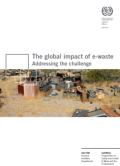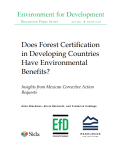This Synthesis Report is based on an 18-month project, Greening China’s Financial System, carried out by the International Institute for Sustainable Development (IISD) and the Finance Research Institute (FRI), Development Research Center (DRC) of the State Council, in association with the United Nations Environment Programme (UNEP) Inquiry into the Design of a Sustainable Financial System, and with support from the Fridtjof Nansen Institute. The aim is to develop specific proposals for greening China’s financial system, based on an analysis of current practice in China and an exchange of experience with international experts.



This discussion paper hypothesizes that these findings were at least partly driven by the tendency of FSC certification to attract already- sustainably managed forests and by the governance challenges of community forestry in developing countries. One implication is that policymakers using FSC certification to generate environmental benefits may want to target forests with less-than-stellar management—particularly in the case of reduced emissions from deforestation and degradation (REDD) initiatives that emphasize improvement beyond business-as-usual—and to build the community and legal institutions needed for sustainable forestry.
This paper presents three individual cases of a wind turbine producer, a wind farm and a wind blade producer to illustrate how foreign collaboration and technology, choice of deployment strategy, and government policy have influenced the sector to continually improve its technology. The findings indicate that foreign technology and collaboration have had a significant role in helping wind energy technology to develop in China, and were also key elements in stimulating indigenous innovation when high prices held the domestic wind market back from massive expansion. While public policy has played a key role in many aspects of the development of the innovation path, the long-term, enduring goal of developing the required technology was the essential driver. The development of the wind sector occurred alongside the economic development and social improvement of the nation. Thus, while it may be too soon to predict the future path of innovation for Chinese wind energy technology, an emphasis on research and development and increasing international competition is a trend that is likely to continue.
